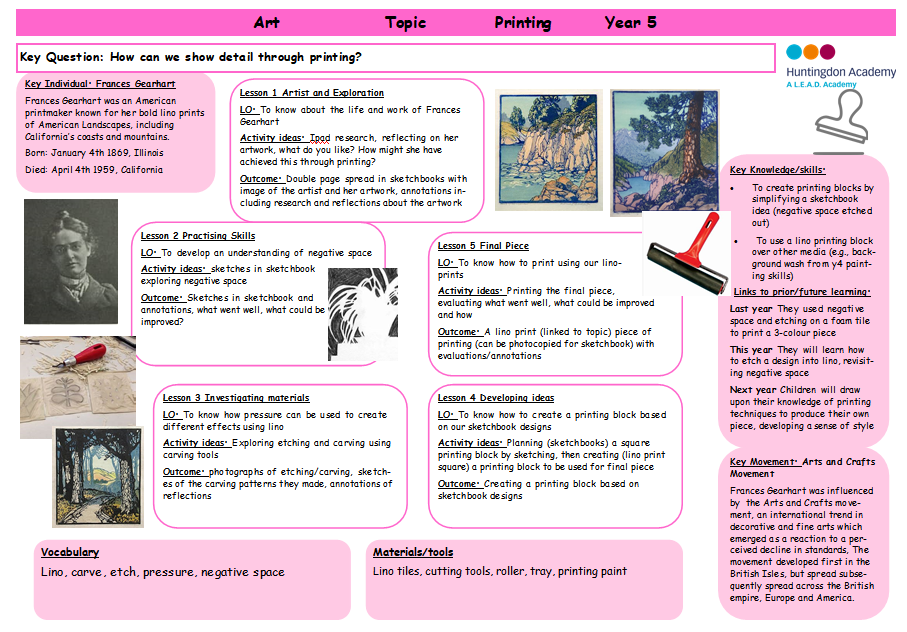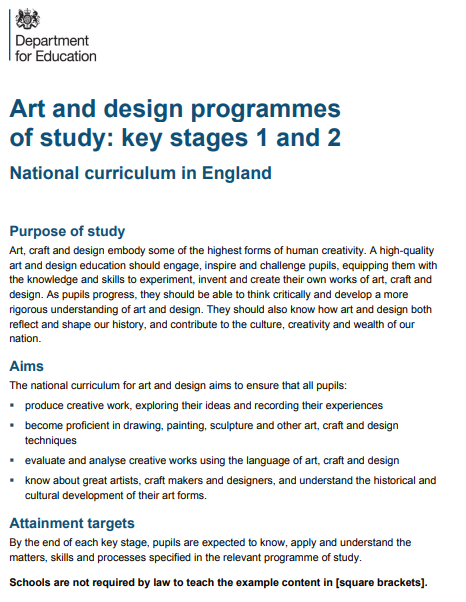Welcome
Welcome to art at Huntingdon. On this page you will find out the key information about the leadership, design and implementation of our art provision.

Art at Huntingdon is led by Alice Lindsey. Alice believes that art is a vital part of the creative curriculum and gives pupils the chance to expresses feelings and emotions in different ways. She is passionate about the teaching of art and her aim is that all children at Huntingdon leave us having had exposure to a wide variety of art styles, techniques and artists.
Our governor for Art and Design is Sue Love.
The art ambassadors are; Ashley, Xianhong, Suhani, Nali, Arceus, Amiya-Rose, Lainda, Mina, Fizah and Amelia
Subject Overview
We want our children to leave Huntingdon Academy being motivated, responsible, respectful, innovative and creative life-long learners.
Our art curriculum aims to inspire in pupils a curiosity and fascination of art that will remain with them for the rest of their lives. It is vital that our children have the opportunity to learn and enjoy art, know about great artists and understand the historical and cultural development of their art forms.
Therefore at Huntingdon Academy, we have an exceptional duty of care to ensure that children become proficient in drawing, painting, sculpture and other art, craft and design techniques. We aim to provide our children with meaningful art experiences where they will have the opportunity to learn and enjoy art. For example through visits to Art Galleries and working with local artists.
Our art curriculum will also build on a progression of knowledge, skills and understanding and enables children to gain a wide range of vocabulary from EYFS to the end of Key Stage 2.
It is also through dialogic rich teaching approaches and the use of oracy as a vehicle for learning in art that we encourage pupils to articulate ideas, develop understanding and engage with others. This commitment to both presentational and exploratory talk is a powerful tool for learning in art and empowers our students to better understand themselves, each other and the world around them.
Through our teaching we consistently aim to raise awareness of the arts; as a subject and as a potential career field for the future. Children will leave Huntingdon Academy knowing different career prospects for artists.
National Curriculum
Our art curriculum is underpinned but the National Curriculum Programme of Study for Key Stages 1 and 2. The Early Years Foundation Stage Framework underpins the provision provided for our Foundation stage pupils.
Conceptual Knowledge Map
Planning
There are 4 strands of art teaching – drawing, painting, printing and sculpture. Each strand has a linked artist and movement to ensure our pupils have a sound understanding of art history and how themes in art have changed over time. Art is taught at differing time in the year depending on year group, as the teaching is often linked to appropriate wider curriculum big questions and topics.
Each strand of art is taught in a sequence of around 6 lessons, including artist research and exploration, practicing skills, investigating different materials, developing ideas and creating a final piece. Running as a thread through these lessons is our artistic vocabulary and discussions. Each sequence also includes reflections on prior learning to ensure pupils continue to develop their already present skills. An example of a planning sequence in art can be seen below.

SEND and Art
The teachers at Huntingdon appreciate the role that Art and Design has on cultivating creativity. We aim to create inclusive classroom environments which support all learners to fulfill their potential. When planning the delivery of our art and design curriculum, our teaching staff think carefully about how to make the curriculum goals for art accessible and inclusive for all learners. Teachers will consider what will support each child to learn as well as planning for factors which may inhibit a child’s learning. Strategies for supporting learning include: word/picture banks to support vocabulary and spelling, pre-teaching skills and experimenting with materials, clear modelling of skills, using large-scale resources for learners who struggle with fine-motor skills and using a variety of media e.g. paintbrush/pencil thickness. Our teachers are committed to creating an inclusive environment and the unique, creative nature of art and design as a subject helps us to promote this.



